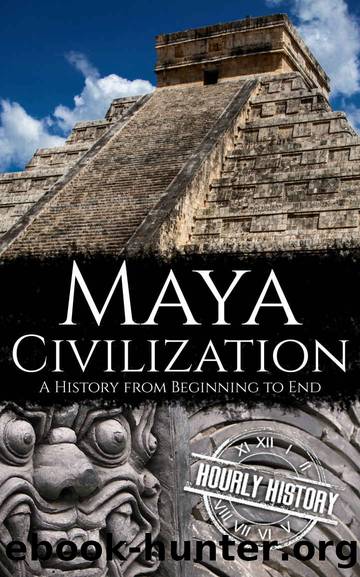Maya Civilization: A History from Beginning to End (Mesoamerican History Book 3) by Hourly History

Author:Hourly History [History, Hourly]
Language: eng
Format: epub
Published: 2020-01-05T00:00:00+00:00
Chapter Six
The Post-Classic Period: 900-1539 CE
âFor the Maya, the Post-Classic period was a time of complex and profound changes.â
âSylvanus Griswold Morley, The Ancient Maya
Although the end of the Classic Period saw the abandonment of some major Maya cities in the southern lowlands, Maya civilization did not disappear. Instead, the Maya concentrated in the northern Yucatán Peninsula. Maya cities already in the area grew, and new cities were built. The Maya in the Post-Classic Period, however, faced some new challenges. One of the most notable was the switch from cities located mainly in a damp, humid, rainforest environment to the much drier climate of the Yucatán Peninsula.
The city which came to dominate this period in Maya history was Chichén Itzá, in northern Yucatán. This city had been founded around 600 CE, but it wasnât until the abandonment of Tikal and Calakmul in 900 CE that it became the largest and most prosperous Maya city. As Chichén Itzá became more prominent, two other Maya cities in the immediate areaâYaxuna in the south and Coba in the eastâbegan to diminish in size and importance. These two cities had previously been allies, but as first Coba and then Yaxuna lost territory to Chichén Itzá, both became notably less powerful.
Thus, during the tenth century, Chichén Itzá became the most important cultural, military, political, and trade center of the Maya civilization. The central part of the cityâcomprising temples and residences for the king, the royal family, and important noblesâcovered more than five square kilometers. The temples in the center of the city were built on an area which was artificially leveled and included the Temple of Xtoloc and the Temple of Kukulcan, which incorporated a stepped pyramid over 100 feet tall. This pyramid, El Castillo, is more than simply a monument to Maya religionâit is the Maya calendar set in stone. Each of the four staircases has 91 steps and when added together with the single step leading to the main temple gives a total of 365 steps. Precisely at sunset on the spring equinox, the heads and tails of the serpents which decorate the main staircase are joined by a body of shadow. The orientation and placement of decoration on this pyramid also highlight many other important events within the Maya calendar. To create such a precisely aligned stone building of this size would be challenging in any circumstances, but to do so without the benefit of the wheel or metal tools and solely using human muscle is an astonishing achievement.
The central part of Chichén Itzá also incorporated more than 13 ball courtsâthe games played in these courts were not simply sport but formed part of religious rituals. The largest ball court, the Great Ball Court, is the largest ever discovered in the Americas, measuring over 550 feet in length and incorporating the Temple of the Jaguar built into one of its walls. This central part of the city was surrounded by a much larger expanse of smaller and sometimes temporary residences.
All the important buildings
Download
This site does not store any files on its server. We only index and link to content provided by other sites. Please contact the content providers to delete copyright contents if any and email us, we'll remove relevant links or contents immediately.
| Africa | Americas |
| Arctic & Antarctica | Asia |
| Australia & Oceania | Europe |
| Middle East | Russia |
| United States | World |
| Ancient Civilizations | Military |
| Historical Study & Educational Resources |
Magic and Divination in Early Islam by Emilie Savage-Smith;(1500)
Ambition and Desire: The Dangerous Life of Josephine Bonaparte by Kate Williams(1344)
Bohemians, Bootleggers, Flappers, and Swells: The Best of Early Vanity Fair by Bohemians Bootleggers Flappers & Swells- The Best of Early Vanity Fair (epub)(1343)
Papillon by Henry Charrière(1310)
Twelve Caesars by Mary Beard(1256)
Operation Vengeance: The Astonishing Aerial Ambush That Changed World War II by Dan Hampton(1136)
What Really Happened: The Death of Hitler by Robert J. Hutchinson(1128)
London in the Twentieth Century by Jerry White(1113)
Time of the Magicians by Wolfram Eilenberger(1089)
The Japanese by Christopher Harding(1086)
Twilight of the Gods by Ian W. Toll(1084)
Lenin: A Biography by Robert Service(1045)
The Devil You Know by Charles M. Blow(985)
A Social History of the Media by Peter Burke & Peter Burke(936)
Freemasons for Dummies by Hodapp Christopher;(922)
Napolean Hill Collection by Napoleon Hill(902)
Henry III by David Carpenter;(891)
The Churchill Complex by Ian Buruma(881)
The Rise and Triumph of the Modern Self by Unknown(879)
